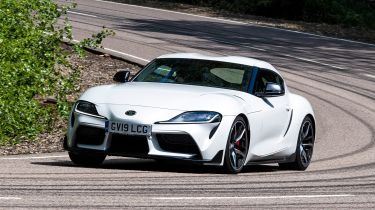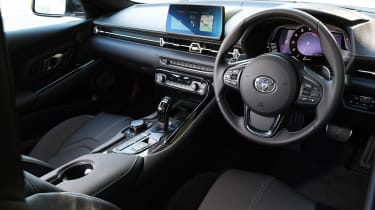Toyota Supra review - Interior, design and technology
Toyota has ensured the Supra looks suitably ready for action, while equipment levels are high
The Toyota Supra shares much of its mechanical underpinnings with the BMW Z4 and this shows in the Supra’s wide, short-wheelbase proportions. Outside, Toyota’s design pays tribute to the 1990s sports car of the same name – a long bonnet, large headlights and a squat rear end help give the new Supra a similar presence on the road and a high level of visual drama that’s undeniably important in this class. In fact, the only significant exterior difference between the four- and six-cylinder models is the respective standard 18- and 19-inch alloy wheels. The manual cars get red Supra badges on the rear.
While the Supra’s interior design is different to that of the Z4, with which it shares some of its DNA, in many areas, much of the componentry inside is BMW-sourced. That’s a good thing in some ways, as Toyota’s infotainment technology isn’t up to snuff, even in its most recent cars like the Corolla. Material and build quality fits the price tag though, as does the list of kit.
All Supra versions feature Toyota's 8.8-inch touchscreen infotainment system, with Bluetooth, sat-nav, a DAB radio and USB ports. The 2.0-litre Pro and 3.0-litre versions come with heated Alcantara sports seats, while the 3.0 Pro variant is treated to a leather upholstery upgrade. Extra luxuries for the 3.0 Pro car include a JBL audio system with 12 speakers, a head-up display and a wireless mobile phone charging function.
On the manual Supras, changes had to be made to the dashboard to accommodate the shifter. The top part of the centre console is wider and the controls for the infotainment, drive modes and electronic handbrake are all in different positions.
Sat-nav, stereo and infotainment
As far as the infotainment system goes, Supra buyers get a re-skinned BMW iDrive arrangement, with an 8.8-inch screen. Much of the other switchgear is from the Munich parts catalogue, too. The infotainment works slickly, while the adoption of BMW software means you get Apple CarPlay connectivity for the first time in a Toyota, but Android Auto is not offered.
On our Pro specification test car, the rearmost speakers caused a rattled over bumps – but this issue may have been specific to our early example.




